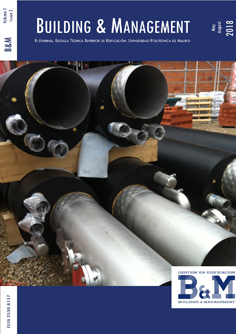Use of the energy of the urban Wastewater network for the thermal conditioning of the swimming pool of the Moratalaz Sports Centre. Madrid = Aprovechamiento de la energía de la red urbana de aguas residuales para el acondicionamiento térmico de la piscina del Polideportivo de Moratalaz. Madrid
DOI:
https://doi.org/10.20868/bma.2018.2.3766Palabras clave:
Urban Infrastructure, Energy, Recovery, Efficiency, Infraestructuras urbanas, Energía, Recuperación, EficienciaResumen
Abstract
Underground networks of urban infrastructures channel fluids, water, sewage, air, mechanical and thermal vehicles, store resources of all kinds, and interact with the underground mean, which allows to preserve a moderate rate of intensity and temperature of the thermal energy that they store and transport, all of it very close to the potential users that these resources could serve as primary resources. It is the case of the Municipal Sports Center, CDM, of Moratalaz, an installation that gives sporting services to about 600,000 users per year and has equipment voraciously consumer of energy resources as it is, in our case, the indoor swimming-pool. The heating of the swimming water, the dehumidifying of the air, the heating of the space and the heating of water of the pool are solved with the production of heat by means of gas boilers. The close existence of a municipal waste-water collector, which runs alongside the CDM, has allowed the existing heat production installation to be hybridized with a new one based on a thermal exchanger, directly installed in the collector's gallery. The monitoring of the operation and consumption of the system has allowed to verify a percentage reduction of emissions of 37.5% and a percentage reduction of energy costs of 39.2%, in the first stage of operation.
Resumen
Las redes subterráneas de las infraestructuras urbanas canalizan fluidos, agua, agua residual, aire, vehículos de todo tipo, almacenan recursos de todo tipo, e interaccionan con el terreno lo que permite preservar una tasa moderada de intensidad y temperatura a la energía térmica que almacenan y transportan , muy cerca de los potenciales usuarios a los que estos recursos podrían servir como recursos primarios. Es el caso del Centro Deportivo Municipal, CDM, de Moratalaz, una instalación que da servicios deportivos a cerca de 600.000 usuarios al año y cuenta con equipamientos vorazmente consumidores de recursos como es, en nuestro caso, la piscina cubierta. El calentamiento del agua de nado, la deshumectación del aire, la calefacción del espacio y el calentamiento de agua caliente sanitaria de la piscina se resuelven con la producción de calor mediante calderas de gas. La existencia de un colector municipal de aguas residuales, que discurre junto al CDM ha permitido hibridar la instalación existente con otra de intercambio instalada en la galería del colector. La monitorización del funcionamiento y consumos del sistema ha permitido verificar una reducción porcentual de las emisiones de un 37,5% y una reducción porcentual de los costes de energía de un 39,2%.
Descargas
Referencias
Pereda L. de, (et Alt) “Guia sobre aprovechamiento energetico de infraestructuras subterráneas”, Fundación de la Energía de la Comunidad de Madrid, 2011.
Guidebook to IEA ECBCS Annex 37. Low Exergy Systems for Heating and Cooling of Buildings. Edited by Mia Ala-Juusela, VTT , Finland. 2003
Pulido Barrera Paola, Rosales Carreón, Jesús , Boer, Hugo J. de 2016.”A multi-level framework for metabolism in urban energy systems from an ecological perspective”. Department of Innovation, Environmental and Energy Sciences, Copernicus Institute of Sustainable Development, Utrecht University, Heidelberglaan 2, 3584 CS Utrecht, The Netherlands , 2018.
Rueda, Salvador. EL URBANISMO ECOLÓGICO. 2018.
Ramírez Andrea. “Why sustainable management of the subsurface needs a feminine touch”Copernicus Institute, November 2015
Beat Kobel, Yann Roth, Ryser et Alt. “Heizen und Kühlen mit Abwasser” Baudirektion Kanton Zürich. 2010.
Descargas
Publicado
Número
Sección
Licencia
Los originales de la revista Building & Management, son propiedad de la Universidad Politécnica de Madrid, siendo necesario citar la procedencia de cualquier reproducción parcial o total.
Todos los artículos originales que se publican en Building & Management quedan sometidos a discusión y al comentario de nuestros lectores. Las opiniones deben enviarse a la dirección de correo electrónico de la revista, dentro del plazo de tres meses, contados a partir de la fecha de su publicación.
Los autores conservan los derechos de autor y garantizan a la revista el derecho de una licencia Creative Commons, Attribution-NonCommercial-NoDerivatives 4.0 International (CC BY-NC-ND 4.0), que permite a otros compartir el trabajo con un reconocimiento de la autoría y uso no comercial.
Los autores pueden establecer por separado acuerdos adicionales para la distribución no exclusiva de la versión de la obra publicada en la revista (por ejemplo, situarlo en un repositorio institucional o publicarlo en un libro).
Salvo indicación contraria, todos los contenidos de la edición electrónica Building & Management se distribuyen bajo una licencia de uso y distribución Creative Commons.




 <
< 








